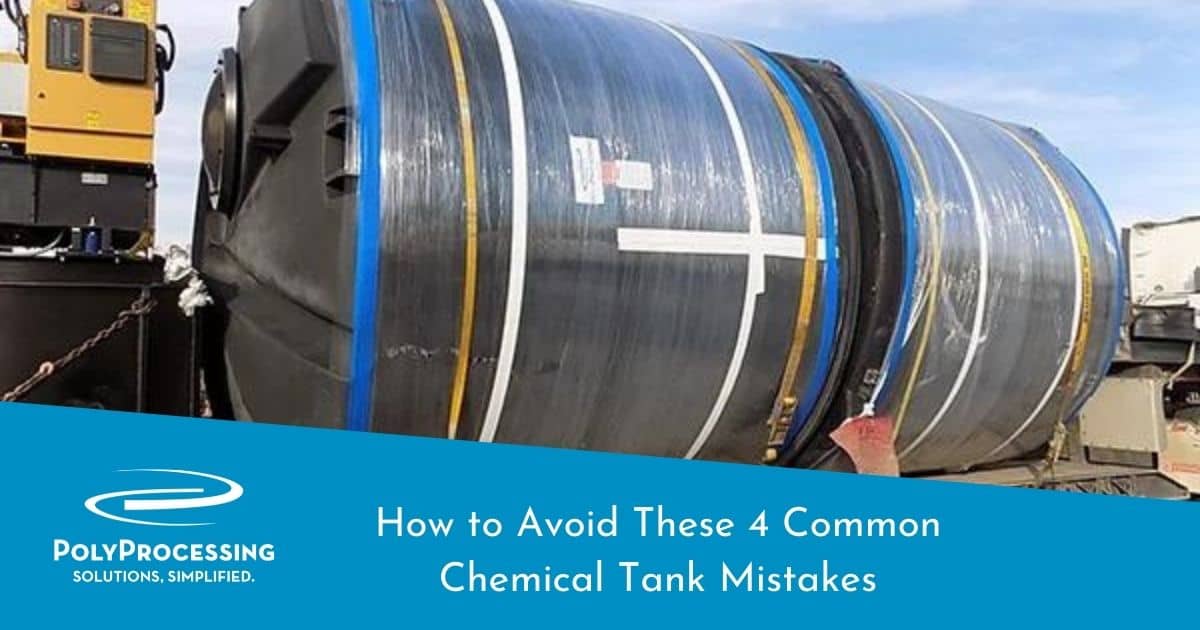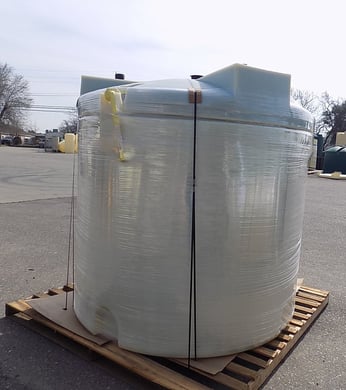How to Avoid These 4 Common Chemical Tank Mistakes
Purchasing and maintaining a chemical storage solution isn’t as simple as making a trip to the hardware store and picking out a tank that’ll do the trick. Unfortunately, many facilities make chemical tank purchases without the proper planning and execution, and the results can be costly.

Over the years, as our team has helped customers configure their chemical storage systems, we’ve seen four common purchasing and maintenance mistakes that can have financial and safety ramifications. While some of these tips might seem simple, it is often their simplicity that causes some customers to overlook them altogether.
1. Incomplete Chemical Information
When designing specifications for a chemical storage tank, a lot of engineers start with size requirements, tank materials, or some other criteria. At Poly Processing, the very first thing we need to know is what kind of chemical will be stored in the tank, and at what concentration. This information drives everything else we do in engineering your storage solution.
Different chemicals produce fumes and require proper venting. Some chemicals call for specific kinds of insulation for outdoor storage. Others require double-wall solutions or fittings.
Be as specific as possible about the chemicals you will be storing. It’s very easy to make simple errors if you only provide a generic chemical name or don’t provide the exact chemical concentration. If the tank is designed for the incorrect chemical, there could be all kinds of hazardous issues, including leaks in fittings, vapor issues, and cracks.
Everything about the tank, from the wall thickness to venting structures—even the color of the tank— starts with knowledge about the chemical.
2. Poor Foundation at the Installation Site
No matter where the tank is installed, a smooth and level foundation is a must. The pad that the tank will rest on needs to be the right size, especially if your tank needs seismic or wind restraints.

We sometimes see pads that are sized properly for the tank, but not the seismic clips. Think ahead and ask questions about seismic and wind restraints. Will the installation be a permanent fixture? If so, the pads more than likely will be concrete.
If the tank pad isn’t the right size or thickness, your tank will have to be pulled off its site while a proper-sized pad is installed, and then reinstalled afterwards. This process is expensive and time-consuming.
We can help you think through your foundation and pad requirements early on. Our Tank Installation Guide is a helpful place to start walking through all the questions you should be prepared to address. Let us help you with your tank system.
3. Missing or Improper Off-Loading Equipment
 One of the most frequently overlooked considerations is offloading equipment. When your tank arrives at your facility, you’ll need to have the right kind of equipment onsite to lift the tank off the truck and onto the installation site.
One of the most frequently overlooked considerations is offloading equipment. When your tank arrives at your facility, you’ll need to have the right kind of equipment onsite to lift the tank off the truck and onto the installation site.
Depending on the size of the tank, you’ll need a crane or forklift with extended forks. It’s critical that you have the right equipment to move the tank from point A to point B without causing any damage to the tank, its fittings and accessories, or your surroundings.
Improper installation equipment could also leave your plant susceptible to harm if the tank lands somewhere it shouldn’t. There could be other chemicals that spill or plant walls that are compromised. It’s an expensive mistake that you will definitely want to avoid at all costs.
Our installation manual provides offloading instructions. We strongly recommend using a professional rigger/contractor.
4. Failing to Inspect Purchased Tanks
Your planning doesn’t end when your tank is installed. Yearly inspections are vital to maintaining safe chemical storage. Some customers fail to do annual tank inspections, setting themselves up for serious problems.
A minor issue with a tank’s fitting or improper temperature settings could lead to major problems down the road. Small issues that aren’t corrected can eventually compromise the tank’s integrity, potentially leading to chemical spills and cracks in the tank.
Check your chemical storage system, including the tank’s fittings and gaskets once a year with our Installation Guide to avoid dangerous and costly scenarios.
You can avoid costly purchasing and maintenance mistakes by taking the time to plan carefully and anticipate your tank’s needs. Get a head start on your prep work by downloading our Tank Installation Guide.
Still have questions? Contact a chemical storage tank expert to get the custom help you need!
- March 21, 2022
- Topics: Installation and Field Service
About Poly Processing
Posts By Topic
Tech Talk Podcast Episodes
Subscribe By Email
Recent Posts
- The Best of 2025 - Top 5 Chemical Storage Blogs
- Installation Tips for Chemical Storage Tanks: Site Preparation and Offloading
- Understanding pH and Chemical Concentration When Choosing a Chemical Tank
- Maximizing Fill Efficiency: Selecting the Optimal Fill Line System
- Chemical Storage Tanks: A Quick Guide for End Users
Tank Configurator

Find the recommended tank and system components for your chemical storage challenge.
Configure a Tank Package




